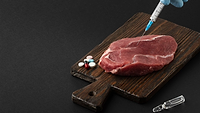Residues of Pesticides Containing PFAS Tripled in EU Produce Over Last Decade

Image credit: Elena Mozhvilo via Unsplash
In the EU, a total of 37 active substances used as pesticides on food crops are per- and polyfluoroalkyl substances (PFAS), also known as “forever chemicals” due to their inability to break down in the environment or the human body. PFAS have been an issue of increasing concern in recent years, as the body of scientific evidence pointing to the chemicals’ human health harms mounts.
A recent analysis of official EU pesticide monitoring data has revealed that the average proportion of produce containing PFAS pesticide residues has nearly tripled over the last decade. The analysis was conducted by Pesticide Action Network (PAN) Europe, which is a science-based organization working to eliminate dependency on synthetic pesticides. PAN Europe comprises 48 member organizations from 28 European countries.
According to the PAN Europe report, among their many uses, PFAS are used in pesticides, either as active substances or as co-formulants, to increase the effectiveness of pesticides against pests. In the first proposal for universal PFAS restriction in the EU, an official list of PFAS active substances was published. At present, 37 of these 47 substances, representing 16 percent of the synthetic active substances approved in the EU, are still authorized for use as pesticides in food production.
To determine the scale of PFAS pesticide contamination of fruit and vegetables sold in the EU, PAN Europe analyzed data from the national monitoring programs for pesticide residues in food across EU Member States, spanning the years 2011–2021. In total, residues of 31 different PFAS pesticides were detected in EU produce during this time period.
PAN Europe found the average proportion of fruit and vegetables containing residues of at least one PFAS pesticide in the EU has nearly tripled over the decade. It has risen by 220 percent for EU fruit and by 247 percent for EU vegetables. The most pronounced average increase occurred for apricots (+333 percent), peaches (+362 percent), and strawberries (+534 percent).
On average, 18 percent of imported fruit were contaminated with residues of PFAS pesticides in 2021, which is slightly less than European-grown fruit (20 percent of fruit). While European-grown vegetables (12 percent) were on average less heavily contaminated with residues of PFAS pesticides than fruit (20 percent), some were especially polluted: chicories (42 percent), cucumbers (30 percent), and peppers (27 percent).
The most frequently contaminated products were grown by the Netherlands (27 percent) and Belgium (27 percent), followed by Austria (25 percent), Spain (22 percent), and Portugal (21 percent). Among imported fruit and vegetables, the most likely to contain PFAS pesticide residues were from Costa Rica (41 percent), India (38 percent), South Africa (28 percent), Colombia (26 percent), and Morocco (24 percent).
In European-grown products, the most often detected PFAS active substances in 2021 were the fungicide fluopyram, the insecticide flonicamid, and the fungicide trifloxystrobin.
PAN Europe also warns about the “cocktail effect” arising from a combined dietary and non-dietary exposure to several chemical substances, including different pesticides or other chemicals, which has still not been assessed by regulators when setting maximum residue limits (MRLs) for chemicals. For example, residues of up to four different PFAS pesticides were detected in a single sample of EU-grown strawberries and table grapes. Similarly, residues of up to three different PFAS pesticides were detected in a single sample of peaches, apricots, pears, and apples.
PAN Europe urges four policy demands in its report: to ban active PFAS in pesticides, to ban the manufacture and export of PFAS pesticides, to apply a zero-residue policy in food, and to move toward pesticide-free agriculture.
Looking for a reprint of this article?
From high-res PDFs to custom plaques, order your copy today!






